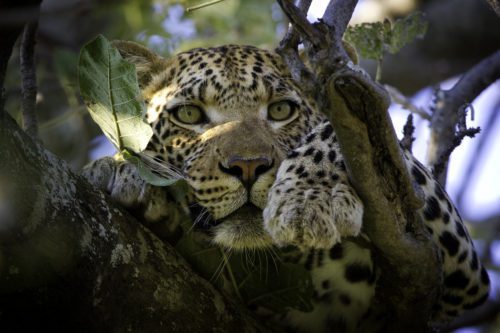Botswana, known for its uncrowded wilderness, outstanding wildlife, and dreamy camps is a top choice for a luxury safari. Within the relatively small country, you’ll find both the lush Okavango Delta and the bewitching desert landscapes of the Central Kalahari and Makgadikgadi Salt Pans. The question of when to go on safari in Botswana should be a simple question to answer. (More often than not, dictated by dry season, wet season, and the shoulder months that abridge them.) However, the natural phenomenon that makes Botswana such a unique destination—flood waters rolling off the Angolan Highlands that sweep across the Okavango Delta each year—means some nuance is required to answer the question with any integrity. Whether you want to witness the second-greatest migration in Africa or enjoy the tranquility of a mokoro safari through reed-filled channels, this guide will help you determine when to go on a Botswana safari.
The Best Time of Year to Go on Safari in Botswana (and why)
Conventional wisdom says the best time to visit Botswana is June through September when the weather is dry, temperatures are pleasant, the foliage is thin (making wildlife easier to spot), and wildlife is concentrated near water sources. In the Okavango Delta, big game concentrates on shrinking tracts of dry land; the rest of the year, wildlife flocks to permanent water channels.
Botswana climate guide
Landlocked Botswana is located in southern Africa and experiences seasons opposite to those in the United States. Summer and winter are distinct, with observable temperature and precipitation trends. Fall and spring tend to be brief and mild. As such, it’s more helpful to think in terms of wet and dry seasons—and it’s practical to differentiate between Botswana’s well-traveled north and its Kalahari-cloaked heartland, which have entirely different ecosystems.
Caveat: Climate change is significantly affecting the predictability of seasonal weather patterns. The information outlined below is based on historical norms; consider it a trend rather than the rule.
Okavango Delta, Linyanti & Chobe National Park (north)
- Dry season runs from June to October, which also coincides with peak season.
- In the northwest corner of the Delta, flood waters begin to arrive in June. The highest water levels are measured in July and August and by this time, reach the southeastern portion of the Delta. Because this is not a climate event associated with rainfall (the floodwaters originate in the Angolan highlands and take four or five months to arrive in Botswana), dry season is when the Delta is fully flooded—a counterintuitive notion that can be tricky to wrap your mind around!
- The Okavango Delta is one of the few inland deltas that do not flow into a sea or ocean. Instead, water soaks into the Kalahari sands. Although camps in the southern Delta receive water last, they also lose it first as water recedes in the direction it arrived. As such, northern camps have the longest flood season.
- October is generally the most uncomfortable month in terms of heat and humidity. However, if you can stand the heat, you’ll be rewarded with the best wildlife viewing.
- With the arrival of November rains, the skies are cleansed and precipitation coaxes foliage from trees, painting the landscape green. It’s the “wet” season, but remember, Botswana is not the tropics, so you’re not likely to be trapped at camp all day by rain. More realistically, precipitation collects over the day, releasing as an afternoon shower that yields to a cool evening.
- In the Delta, there are camps located on permanent water channels. It’s very much possible to experience year-round water activities (boat and mokoro safaris, even if you’re not visiting when the Delta is flooded. These camps also benefit from the wildlife that wanders nearby, attracted to reliable water sources.
The Central Kalahari
- The best time to visit the Central Kalahari is December, January, and February. Precipitation paints the landscape green and attracts tens of thousands of zebra making a north-south migration. (Otherwise, wildlife viewing in the Kalahari is quite lean.)
- From May to November, the Central Kalahari boasts little in terms of wildlife and temperatures can reach freezing at night.
Makgadikgadi, and Nxai Pan National Park
The Makgadikgadi Basin can be visited year-round, but precipitation will dictate which activities can be enjoyed on the pan.
- The dry season runs from April to October, and this is when you will experience the landscape as a salt-crusted, lunar lookalike. It’s the best time to enjoy quad biking and starry sleep-outs.
- During the wet season, the landscape is painted green. It’s a great time to lean into cultural experiences guided by Indigenous bushmen, to spot flamingos and migratory birds arriving to nest, and to witness migrating wildebeest and zebra.
When to safari in Botswana: Month by month
Visiting Botswana in January
It’s wet season, so landscapes across Botswana are painted emerald. Dense vegetation can make wildlife spotting more challenging; January is not an especially productive month for wildlife viewing in the Delta. Wildebeest and zebra are migrating from north to south in spectacular fashion, making their way to Botswana’s central deserts—a sight to behold. Migratory birds are also arriving. Temperatures are high and thunderstorms are apt to roll through.
Visiting Botswana in February
February is still wet season, with occasional afternoon showers. Wildlife has dispersed as water sources have become more abundant, making it harder to spot animals. However, this is a great time to witness birthing season for many species which attracts predators looking for an easy meal. The land remains lush and vibrant, though the Makgadikgadi Basin can get a bit mucky.
Visiting Botswana in March
March is the tail end of the rainy season in Botswana, with sporadic showers and the occasional thunderstorm. The vegetation is still dense, but wildlife sightings begin to improve as animals gather around permanent water sources. The temperatures are still high, but the humidity starts to decrease towards the end of the month. It’s a great time for photographers to visit.
Visiting Botswana in April
April marks the transition from the rainy season to the dry season. The bush starts to thin out, making it easier to spot wildlife. The temperatures relent, offering pleasant weather during the day and cooler nights. It is shoulder season, bridging the gap between the wet and dry seasons.
Visiting Botswana in May
May is the beginning of the dry season in Botswana, and the landscapes transform as the vegetation continues to recede. Wildlife sightings continue to improve as animals congregate around water sources. Mid-to-late May is an excellent time to slip in before peak season rates take effect in June.
Visiting Botswana in June
Flood waters have arrived in the Okavango Delta and peak season is in full swing in Botswana’s north and in the Makgadikgadi Basin. The weather is dry and, in the northern Delta, wildlife is increasingly concentrating on shrinking tracts of dry land. Boat safaris, mokoro safaris and other water-based activities are on offer. It’s a great time for thrill seekers to visit Makgadikgadi Salt Pans for quad biking.
Visiting Botswana in July
July is the heart of the dry season in Botswana. The Okavango Delta is very much flooded. In Chobe National Park and the Linyanti region, prey and their predators congregate at water sources. Landscapes are dry and sparse, allowing for excellent visibility and wildlife spotting. Daytime temperatures in the desert are mild but nights can be quite chilly.
Visiting Botswana in August
August is still firmly peak season in Botswana, with dry, cool weather prevailing. Water levels in the Delta are reliably high. The wildlife sightings remain excellent; this is an ideal time for mokoro and boat safaris. In the north, Chobe National Park swells with crowds.
Visiting Botswana in September
It’s still dry, so wildlife remains concentrated near water sources and persistently low rainfall means tree canopies are thin and the grass is low. Game viewing is excellent, and crowds have thinned with holidaying families returning home for the school year. Temperatures are on the rise.
Visiting Botswana in October
October is considered the shoulder season in Botswana, transitioning from the dry season to the rainy season. The heat and humidity can be uncomfortable, but for those who can stand it, wildlife viewing is at its best. It’s also an excellent time to go catch-and-release fishing.
Visiting Botswana in November
It’s hot; the historical mean temperature is 77°F, but the mercury often stretches toward the low 90’s. Precipitation is coaxing green back into the landscape. Rainstorms are increasing in frequency, typically building over the day and with clouds bursting in the late afternoon resulting in a clear evening.
Visiting Botswana in December
Eclipsed only by the rainfall witnessed in January, December is peak rainy season. The landscape is once again full and lush. Wildlife sightings can be more challenging due to the dense foliage and the fact that animals disperse away from permanent water holes. With the exception of December 20 to January 5 travel dates, camps are offering secret season incentives which will be extended through to March.
Luxury Botswana safari itineraries

- Itinerary
Gems of the Okavango Delta
Private concessions in a classic destination

- Itinerary
An Ultra-Luxurious Safari in Botswana
Conservation and luxury go hand in hand in this classic Okavango Delta itinerary

- Itinerary
Across Botswana: Delta and Desert
Going off the beaten path in the Okavango and Kalahari
Plan your Trip
Ready to start planning your own incredible adventure? We make the process stress-free and enjoyable.
